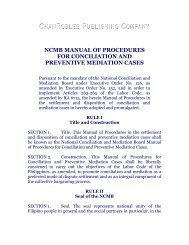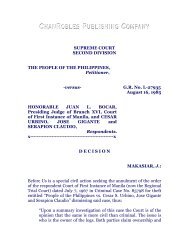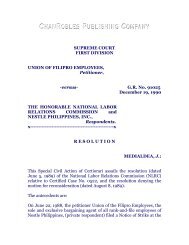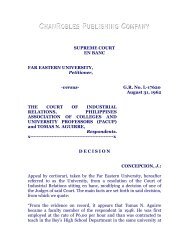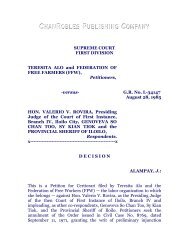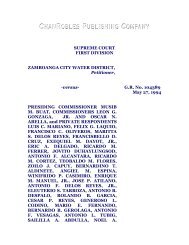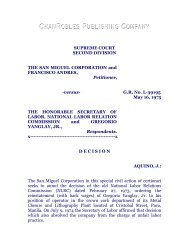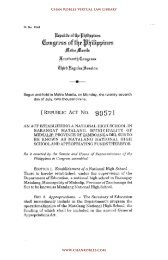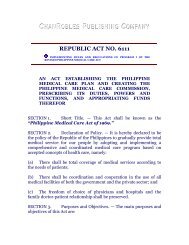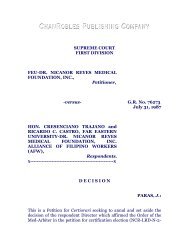Olac vs. CA, G.R. No. 84256, Sept. 2, 1992, 213 SCRA 321
Olac vs. CA, G.R. No. 84256, Sept. 2, 1992, 213 SCRA 321
Olac vs. CA, G.R. No. 84256, Sept. 2, 1992, 213 SCRA 321
Create successful ePaper yourself
Turn your PDF publications into a flip-book with our unique Google optimized e-Paper software.
SUPREME COURT<br />
THIRD DIVISION<br />
ALEJANDRA RIVERA OLAC, ANTONIO<br />
OLAC, THERESA RIVERA and<br />
FELOMINO ESCOBAR,<br />
Petitioners,<br />
-versus- G.R. <strong>No</strong>. <strong>84256</strong><br />
<strong>Sept</strong>ember 2, <strong>1992</strong><br />
THE HONORABLE COURT OF<br />
APPEALS, PROCULO RIVERA and<br />
LEONA SIENES,<br />
Respondents.<br />
x----------------------------------------------------x<br />
D E C I S I O N<br />
NOCON, J.:<br />
This is a Petition for Review on Certiorari filed by spouses Alejandra<br />
Rivera and Antonio <strong>Olac</strong>, and Theresa Rivera and Felomino Escobar,<br />
assailing the decision of the Court of Appeals rendered on March 15,<br />
1988, raising the following as errors: chanroblespublishingcompany<br />
“(a) In denying an execution as a matter of right and in<br />
upholding that “the matter in issue in this case involves the
exercise of the discretion of the respondent Judge, which we<br />
find valid and legal. chanroblespublishingcompany<br />
“(b) In holding that “the dispute on the execution of the<br />
partition portion arose with respect to the 15-hectare lot<br />
claimed by the therein petitioners”, obviously referring to the<br />
fifth paragraph of the decision of the court a quo. chanroblespublishingcompany<br />
Petitioners filed a petition for certiorari and mandamus with the<br />
Court of Appeals praying among others that a writ of mandamus be<br />
issued directing respondent Judge Pedro C. Gabaton of the Regional<br />
Trial Court, 7 th Judicial Region, Branch XLI of Dumaguete City, to<br />
issue a writ of execution of the decision rendered by Judge Cipriano<br />
Vamenta, Jr. of the defunct Court of First Instance, 12 th Judicial<br />
District, Branch III in Civil Case <strong>No</strong>. 4744 for partition, recovery and<br />
accounting. chanroblespublishingcompany<br />
The properties subject of Civil Case <strong>No</strong>. 4744 were described in the<br />
original complaint as:<br />
“1. A parcel of land bounded on the <strong>No</strong>rth by Andres Jordan;<br />
on the East by Cabangahan Creek; on the South by Clodualdo<br />
Calooy and Proculo Rivera; on the West by the Sicopong River;<br />
with an approximate superficial area of 20,000 sq. m., more or<br />
less, assessed at P500.00 under Tax Dec. <strong>No</strong>. 1835; and chanroblespublishingcompany<br />
“2. A parcel of land bounded on the <strong>No</strong>rth by the Sicopong<br />
River; on the East by Proculo Rivera and Clodualdo Calooy; on<br />
the South by Andres Jordan; and on the West by the Sicopong<br />
River, with an approximate superficial area of 26.375 sq. m.,<br />
more or less and assessed at P800.00 under Tax Dec. <strong>No</strong>.<br />
4140.” [2] chanroblespublishingcompany<br />
In their complaint, petitioners Alexandra Rivera and Theresa Rivera<br />
claim to be the legitimate children of private respondent Proculo<br />
Rivera by his first wife, the late Natividad Nuique who died in 1941.<br />
Since the death of Natividad, respondent Rivera had enjoyed the<br />
produce of the said parcels of land to the exclusion of the petitioners<br />
and refused to partition the property in question inspite of demands
y petitioners, thereby forcing them to file the instant complaint with<br />
the trial court. chanroblespublishingcompany<br />
In resolving the conflict between petitioners and private respondents,<br />
the court below made the following findings of fact:<br />
“On the other hand, defendant Proculo Rivera adduced<br />
evidence that during his marriage with Natividad Nuique, he<br />
acquired real property in Amio, Sta. Catalina, Negros Oriental.<br />
He presented a document of sale (Exh. “6”) dated August 1,<br />
1939 purporting to show that he bought said parcel of land from<br />
Antero Maputy. It will be noted that said acquisition occurred<br />
in 1939 during his marriage with Natividad Nuique and before<br />
the death of the latter in 1941. Said property is the same land<br />
described under par. 2 of the complaint and is therefore a<br />
conjugal property of spouses Proculo Rivera and Natividad<br />
Nuique. Defendant also adduced evidence showing that he<br />
acquired a 15-hectare lot during his marriage with Leona Sienes<br />
through homestead application as shown in Exhibit “2” dated<br />
July 23, 1963. chanroblespublishingcompany<br />
“It is the finding of this court that said 15-hectare lot does not<br />
belong to the conjugal partnership between defendant Proculo<br />
Rivera and Natividad Nuique because the same was acquired<br />
after the death of Natividad Nuique and during his marriage<br />
with Leona Sienes.” [2]<br />
On June 18, 1979, the trial court, through Judge Vamenta, Jr.<br />
rendered a decision as follows: chanroblespublishingcompany<br />
“IN VIEW OF ALL THE FOREGOING, judgment is hereby<br />
rendered:<br />
a) Declaring the two parcels described in the complaint<br />
as the conjugal properties of defendant Proculo<br />
Rivera and his first wife Natividad Nuique; chanroblespublishingcompany<br />
b) Ordering the partition of said two lots into two equal<br />
parts; chanroblespublishingcompany
c) Pursuant to Rule 69, Rules of Court, the parties are<br />
ordered to submit a deed of partition of the lots in<br />
question for approval of the court within thirty (30)<br />
days from the service of copy of the decision, and in<br />
case of failure thereof, commissioners shall be<br />
appointed to effect the partition; and<br />
d) Condemning the defendants to pay plaintiffs the sum<br />
of P5.000.00 as moral damages, and P1,000.00 for<br />
attorney’s fee.” [3] chanroblespublishingcompany<br />
Apparently the decision failed to state clearly whether the 15-hectare<br />
lot, which supposedly belongs to the conjugal property of Proculo and<br />
Leona, is an entirely distinct property from the two parcels of land<br />
described in the complaint or whether it forms part of said two<br />
parcels. As a result, the partition of the properties in question was not<br />
fully executed, there being a dispute on how the parcels of land was to<br />
be partitioned. chanroblespublishingcompany<br />
On <strong>No</strong>vember 27, 1981, Judge Vamenta, Jr. issued an order to clarify<br />
his decision, stating among others that:<br />
“It is the view of the Court that the decision rendered in this<br />
case is so clear and explicit wherein it orders the partition of the<br />
two parcels of land described in the Complaint whose<br />
boundaries and area are specifically mentioned therein; that no<br />
partition was ordered by the Court on the 15-hectare lot<br />
mentioned in the decision.” [4] chanroblespublishingcompany<br />
Despite the clarification, petitioners contend that the 15-hectare lot<br />
claimed by the respondents is the very same land formerly declared<br />
under Tax Dec. <strong>No</strong>. 1835, [5] subject matter of their complaint, and<br />
which the trial court ordered to be partitioned being the conjugal<br />
property of Proculo and his first wife Natividad. chanroblespublishingcompany<br />
On the other hand, respondents maintain that the 15-hectare lot,<br />
denominated as lots <strong>No</strong>. 2230 and 2231, are distinct and separate<br />
from the properties stated in the complaint. chanroblespublishingcompany
In view of the conflicting claims, the trial court appointed<br />
commissioners to effect partition of the properties pursuant to the<br />
June 18, 1979 decision. The first commissioner appointed, Edilberto<br />
D. Elmido, Municipal Treasurer of Sta. Catalina, Negros Oriental,<br />
reported inability to equitably partition the properties in question<br />
because of the conflicting claims of the petitioners and the<br />
respondents in the matter of the area of the property sought to be<br />
divided. [6] chanroblespublishingcompany<br />
Consequently, the court appointed another set of commissioners on<br />
June 4, 1982, composed of Casildo Gabo, Feliciano Zerapuelas and<br />
Atty. Elizur Umbac, who made the following findings and<br />
recommendations:<br />
“1. It is hereby recommended that Lot <strong>No</strong>. 2231 be excluded<br />
from the court prohibition and be partitioned into equal<br />
parts between both parties. chanroblespublishingcompany<br />
“2. The description of the second parcel of land coincides with<br />
Lot <strong>No</strong>. 2229 and not Lot <strong>No</strong>. 2230. The evidence (Exhibit<br />
“6”), however, shows that the lot mentioned in Exhibit “6”<br />
is within Lot 2230 which is covered by a Homestead Patent<br />
and which the Court declared to be not subject of partition.<br />
In other words, the second parcel as described in the<br />
complaint is not the same as the lot described in Exhibit<br />
“6”. The issue on this point must therefore be settled.<br />
Hence the Commission cannot recommend partition of any<br />
of these lots above-mentioned.” [7] chanroblespublishingcompany<br />
When the parties manifested their dissatisfaction with the<br />
recommendations of the second set of commissioners, the court<br />
appointed a third commissioner in the person of Engineer Melchor<br />
Catadman with a mandate to relocate and partition the properties<br />
mentioned in the complaint. Engr. Catadman made the following<br />
findings: chanroblespublishingcompany<br />
“The order mentioned of 2 parcel of land (sic) covered by Tax<br />
Declaration in which no technical description, thus cannot be<br />
relocated (sic). However, Tax Declaration <strong>No</strong>. 11819 has two (2)<br />
lots mentioned, Lots 2230 and 2231, Pls-404-D, situated at
Amio, Sta. Catalina, Negros Or. & Mr. Proculo Rivera presented<br />
Psu-07-03-003437, surveyed in the name of Leona Sienes,<br />
adjacent to Lots 2230 & 2231, Pls-404-D on the western side.” [8]<br />
Based on the foregoing, Judge Gabaton issued an Order dated August<br />
11, 1986 modifying the previous order of Judge Vamenta, Jr. by<br />
adopting the recommendation of the second set of commissioners<br />
headed by Atty. Umali. The dispositive portion of said order of Judge<br />
Gabaton reads, as follows:<br />
“WHEREFORE, premises considered, in the interest of justice,<br />
this court hereby ordered (sic) the partition of Lot <strong>No</strong>. 2231 only<br />
and submit the deed of partition within thirty (30) days from<br />
receipt of this Order.” [9] chanroblespublishingcompany<br />
<strong>No</strong>te, however, that according to the commissioners led by Atty.<br />
Umbac, lot 2231 is included in the 15-hectare lot which was declared<br />
conjugal property of spouses Proculo and Leona. The report of the<br />
commissioners state: chanroblespublishingcompany<br />
“If we examine the boundaries of Parcel “A” or Lot 2231 in the<br />
sketch in page 3 of this report, [10] it would appear that said first<br />
parcel [11] is either included in Lot 2231 or both first parcel and<br />
Lot 2231 are one and the same. The boundaries of these two<br />
parcels of land coincide. However, in view of the court<br />
prohibition not to partition the 15-hectare lot, of which Lot 2231<br />
is included, Lot 2231 cannot be included in the partition<br />
without amendment of the court decision.” [12] chanroblespublishingcompany<br />
On <strong>Sept</strong>ember 2, 1987, the same judge issued another order<br />
reconsidering and setting aside his previous order of August 11, 1986,<br />
the dispositive portion of which, reads:<br />
“The main action in this case is the motion for execution of a<br />
decision which has long become final and executory but since<br />
execution could not be done without relocating first the parcels<br />
of land in questioned (sic), this Court appointed a<br />
commissioner to relocate the same but the same could not be<br />
relocated. That being the case, considering the fact that this<br />
court can no longer alter or change the decision which has long
ecome final and executory, the motion for execution and<br />
relocation are hereby dismissed.” [13] chanroblespublishingcompany<br />
Petitioners moved for reconsideration of the said order of Judge<br />
Gabaton and sought for an alias writ of execution, [14] which was<br />
however denied on <strong>No</strong>vember 16, 1987. [15] On elevating the matter to<br />
the Court of Appeals for a writ of mandamus to compel the judge to<br />
execute the decision of June 18, 1979, the petition was dismissed. Said<br />
the appellate court: chanroblespublishingcompany<br />
“A writ of mandamus will not also issue in this case. While it is<br />
true that it is ministerial on the part of the judge to order the<br />
execution of its judgment which has already become final, the<br />
matter in issue in this case involved a property which was<br />
expressly excluded from the partition. The matter involves the<br />
exercise of discretion of the respondent Judge which We find<br />
valid and legal.” [16] chanroblespublishingcompany<br />
From the foregoing, both the trial court and the appellate court agree<br />
that a final judgment can no longer be altered, and thus, it is the<br />
ministerial duty of the judge to order its execution in conformity with<br />
the decision. [17] In the case of Paylago <strong>vs</strong>. Nicolas [18] this Court held<br />
that the writ of execution, as a general principle, must conform<br />
substantially to every essential particular of the judgment issued.<br />
Execution not in harmony with the judgment has no validity. chanroblespublishingcompany<br />
There being no issue that execution is proper, We find that the real<br />
controversy lies on which properties are subject to partition. It is not<br />
amiss to say that the decision of June 18, 1979 left much to be<br />
determined. As a general rule, a court judgment should be considered<br />
in its entirety to get the true meaning and intent of any particular<br />
portion thereof. [19] In the present case however, the controversial<br />
decision referred to a certain, exhibit (Exhibit “6”), which supposedly<br />
coincides with the second parcel of the lot subject of the complaint,<br />
and which now appears to be part of the 15-hectare lot declared to be<br />
conjugal properties of spouses Proculo and Leona. chanroblespublishingcompany<br />
Judge Gabaton, instead of ordering the partition of properties subject<br />
of the complaint, hesitated and relied heavily on the pronouncement<br />
in the June 18, 1979 decision that the 15-hectare lot should not be
partitioned totally disregarding the 2 parcels of lot subject of the<br />
complaint, which was ordered partitioned and which order has<br />
become final and executory. chanroblespublishingcompany<br />
Judge Gabaton failed to appreciate the rule that where there is<br />
conflict between the dispositive portion of the decision and the body<br />
thereof, the dispositive portion controls irrespective of what appears<br />
in the body of the decision. The exception being where the inevitable<br />
conclusion from the findings of fact in the opinion is so indubitable<br />
and clear as to show that there was a mistake in the dispositive<br />
portion. [20] chanroblespublishingcompany<br />
But when the dispositive part of a final order or decision is definite,<br />
clear and unequivocal and can be wholly given effect without the need<br />
of interpretation or construction, the same is considered as the<br />
judgment of the court, to the exclusion of anything said in the body<br />
thereof. [21] chanroblespublishingcompany<br />
The dispositive portion or the fallo is what actually constitutes the<br />
resolution of the court and which is the subject of execution, although<br />
the other parts of the decision may be resorted to in order to<br />
determine the ratio decidendi for such a resolution. Where there is<br />
conflict between the dispositive part and the opinion of the court<br />
contained in the text of the decision, the former must prevail over the<br />
latter on the theory that the dispositive portion is the final order while<br />
the opinion is merely a statement ordering nothing. [22] Hence<br />
execution must conform more particularly to that ordained or<br />
decreed in the dispositive portion of the decision.<br />
Premises considered, We find merit in the present petition. Partition<br />
may be effected in accordance with the dispositive portion of the<br />
decision of the court below, the boundaries and area as alleged in the<br />
complaint being clear and distinct. chanroblespublishingcompany<br />
WHEREFORE, this case is hereby remanded to the court a quo for<br />
execution of the decision dated June 18, 1979.<br />
SO ORDERED.<br />
Narvasa, C.J., Padilla and Regalado, JJ., concur.
Melo, J., took no part.<br />
chanroblespublishingcompany<br />
[1] Annex “A” of the Petition; Rollo, p. 20.<br />
[2] Ibid, p. 2; Rollo, p. 104. chanroblespublishingcompany<br />
[3] Annex “1” of Respondents’ Memorandum, p. 3; Rollo, p. 105.<br />
[4] Annex “2” of Respondents’ Memorandum, p. 2; Rollo, p. 107.<br />
[5] Annex “C” of Petition; Rollo, p. 29. chanroblespublishingcompany<br />
[6] Annex “3” of Respondents’ Memorandum; Rollo, pp. 108-109.<br />
[7] Annex “4” of Respondents’ Memorandum, pp. 5-6; Rollo, pp. 114-115.<br />
[8] Annex “11” of Respondents’ Memorandum: Rollo, p. 141.<br />
[9] Annex “14” of Respondents’ Memorandum, p. 3 Rollo, p. 157.<br />
[10] Please refer to Annex “4” of Respondents’ Memorandum, p. 3; Rollo, p. 12.<br />
[11] First parcel refers to the first parcel of lot subject of the complaint, described<br />
as <strong>No</strong>rth, Andres Jordan; East, Cabangahan Creek; South, Clodualdo Calooy<br />
and Proculo Rivera; West, Sicopong River.<br />
[12] Ibid, p. 4; Rollo p. 113. chanroblespublishingcompany<br />
[13] Annex “17” of Respondents’ Memorandum, Rollo, p. 168.<br />
[14] Original Records, pp. 124-125. chanroblespublishingcompany<br />
[15] Annex “18”, Respondents’ Memorandum, Rollo, p. 169.<br />
[16] Decision, p. 5; Rollo, p. 53. chanroblespublishingcompany<br />
[17] Baclayon <strong>vs</strong>. C.A., G.R. <strong>No</strong>. 89132, 182 <strong>SCRA</strong> 761 (1990).<br />
[18] G.R. <strong>No</strong>. 38152, 189 <strong>SCRA</strong> 727 (1990). chanroblespublishingcompany<br />
[19] De Ralla <strong>vs</strong>. Director of Lands, 83 Phil. 491.<br />
[20] Aguirre <strong>vs</strong>. Aguirre, L-33080, 58 <strong>SCRA</strong> 461 (1974).<br />
[21] Contreras <strong>vs</strong>. Felix, 78 Phil. 570: Edwards <strong>vs</strong>. Arce, 98 Phil. 688.<br />
[22] Magdalena Estate, Inc. <strong>vs</strong>. Caluag et al. G.R. <strong>No</strong>. L-16250, 11 <strong>SCRA</strong> 333<br />
(1964). chanroblespublishingcompany


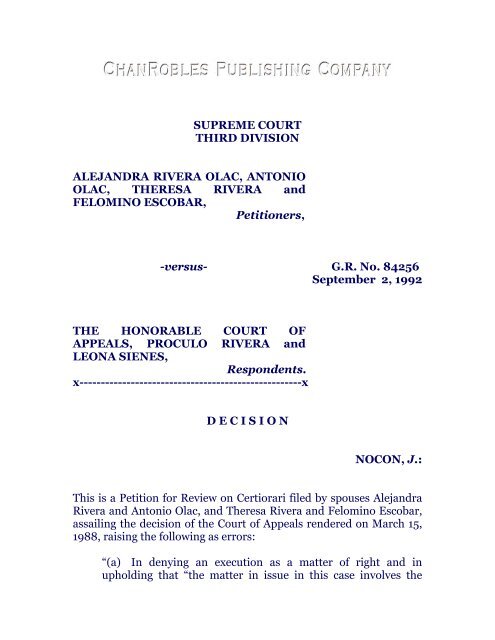
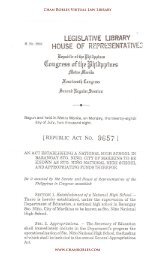
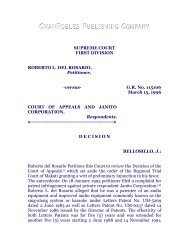
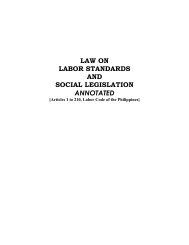
![Aurelio vs. NLRC, (221 SCRA 432 [1993]) - Chan Robles and ...](https://img.yumpu.com/51280528/1/190x245/aurelio-vs-nlrc-221-scra-432-1993-chan-robles-and-.jpg?quality=85)
